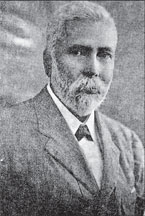|
Cyril Jansz and Emelia Jansz:
The pioneers of English education
by L. Panditharathna
Two pioneers of English education were Cyril A. Jansz and Emelia
Jansz who created generations of English educated people from St. John's
College, Panadura, at a time when English education was not freely
available.
In 1796, Governor Fredric North reorganised the Parish School System
which was introduced by the Dutch. In 1834, as a result of the policy of
giving better status and recognition to English education, the above
schools too became English schools.
In 1841 the Central Schools Commission was appointed for the
administration of the schools.

Cyril A. Jansz |

Emelia Jansz |
Accordingly, a system of State Basic Schools for English Education
was introduced and the Panadura St. John's College was one of them.
The British Government appointed the Colebrook Commission to study
the feasibility of orienting the Sri Lankans for the civil service.
Language gap
An important recommendation was that "there was a language gap
between the British rulers and their subjects in Sri Lanka and as such
the British government should directly get involved in the promotion of
English education".
Another pertinent recommendation was that only those competent in
English should be recruited to the Government service.
The recommendations of the Colebrook Commission promoted the
establishment of State Basic Schools for English.Some of the earliest
schools of the Christian Missionaries were S. Thomas' College, Mt.
Lavina (1876), St. Benedict's College, Colombo (1868), St. Michael's
College, Jaffna (1872), Jaffna Central College (1870), Wesley College,
Colombo (1872) and St. John's College, Panadura (1832).
The British got involved in the World War and could not attend to the
welfare needs of the country. Hence, they handed over all state schools
to the missionaries.
St. John's College was handed over to an Evangelist religious
organisation called the Society for the Propagation of the Gospel (SPG)
The school with about 70 students was housed in the Anglican Church
situated by the Panadura river.
Anglican devotee
In 1876 Suthan de Zoysa, an Anglican devotee of the church
constructed a new building for the church and shifted the school to
another site away from the school. That was the St. John's Boys' School.
The church was consecrated and opened by Governor Sir William Gregory
on June 14, 1876.
The SPG faced a financial crisis and could not look into the needs of
the school which led the teaching staff to leave. A deputation of
parents led by judges and lawyers of the Panadura Courts met the Colombo
Bishop and negotiated for the creation of a fund to run the school and
requested the school to be transferred to Cyril A. Jansz (Snr.) the then
principal.
The Bishop agreed and Jansz became the owner of the school from June
1882.
The first move of Jansz was to pay a courtesy call to the
Vadheebasinghe Ven. Migettuwatte Gunananda thera's temple and pledge
that his mission was not to promote Christianity but English education.
He assured that he would treat all students belonging to various
religions and nationalities alike without any discrimination and
requested the blessings of the Buddhist clergy and laity.
Support
The Thera was highly pleased and assured Jansz his support in running
the school. Later, the thera became a friend of Jansz.
With Jansz becoming the owner, manager and principal of St. John's
College a new ray of hope dawned upon the people of Panadura and their
children.
After the take over Jansz had an uphill task to put up the buildings
and infrastructure for the expansion of the school.
The school housed in a temporary building with 82 students in 1882
grew rapidly and by 1886 had 150 students with seven teachers.
In 1886 Jansz married Emelia Jansz from Tangalle. Mrs. Jansz too was
an educationist.
She started English classes for girls, initially with two girls
studying at her old house. Her class became very popular and in 1887 she
had to put up a building for a girls' school.
Residence
In 1902 Jansz purchased a block of land at Udahamulla with an old
house and made it their residence. In 1903 he built a house and the old
building was converted to a boys' hostel.
In 1915 St. John's School developed rapidly and had a primary, boys'
school, girls' school and a college for higher forms.
By 1924 there were 1400 students. Jansz was a disciplinarian. He was
concerned about the welfare of his students. He was sympathetic to poor
students and provided them free education with food and lodging.
The Johnian Girls' of St. John's Girls' School will launch a walk on
June 15 to commemorate Cyril A. Jansz and Mrs. Emelia Jansz for their
great contributions to English education in Sri Lanka. |


